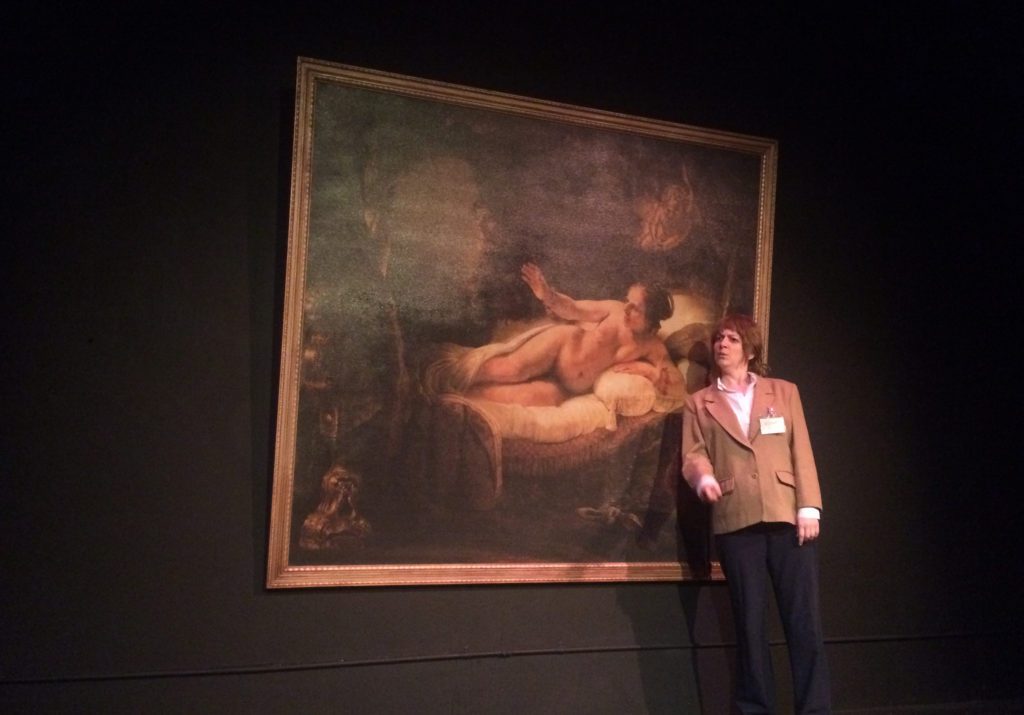Erin Rollman is stunning in Buntport’s “The Rembrandt Room”
But, as any good storyteller knows, the bored-looking guard standing beside the painting has a tale at least as interesting as the Greek myth represented on the hallowed canvas.There’s something antiseptic about a windowless gallery housing priceless treasures. The Old Masters are to be worshipped. Paintings in museums are to be revered. Art is untouchable.
On a blank stage save for an over-sized Rembrandt, we encounter a museum guard. She is detatched, with an itchy collar, bland blazer and comfortable shoes, most often called upon to direct visitors to the rest room. Occasionally she asks them to step back from the paintings and refrain from flash photography. Turns out she is a highly opinionated tour guide to matters of art history and feminism. She also guards a rich personal history.
The Buntport tricksters offer their first one-woman show, “The Rembrandt Room,” capitalizing on the sly talents of Erin Rollman. The play fully draws the audience into the painting in question. Literally and metaphorically, we sit in the dark waiting for light. Beams of light accentuate the action onstage, just as Rembrandt, master of shadow and light, directs our gaze to certain movements and actions within the painting of Danaë.
The renowned painting is a life-sized depiction of the character Danaë from Greek mythology, the guard informs us. The painting hangs in Russia’s Hermitage Museum, where the action is set.
The canvas has a loaded history: it was famously attacked in 1985 by an insane visitor who threw acid on it and cut it with a knife. The restoration took years.
Personal restoration is a slow process, too. But as the guard relates her personal despair, triumphs and oddball observations, we come to see her as she sees the Rembrandt: both are masterpieces and survivors. Both deserve scrutiny and appreciation.
Danaë is depicted as welcoming Zeus, who, according to myth, entered her locked chamber and impregnated her in the form of a shower of gold. Danaë gave birth to Perseus as a result and it didn’t end well: Danaë’s father, the King, had a premonition that he would be killed by a son born to Danaë.
The backstory is equally intriguing: Although the artist’s wife was the original model for Danaë, Rembrandt later changed the figure’s face to that of his mistress. As if that factoid isn’t enough to launch a play.
There’s more.
With detours through Catherine the Great, pregnancy issues, rape and the artist’s self-portrait within the painting, posed peeking around a curtain, the guard slowly reveals herself.
She has a way of touching our most human aspects as she peppers us with questions:
Calamaties befall folks all the time, as predicted in ancient myth, right?
Rollman, a co-founder of Buntport, is riveting throughout, taking us on a wild ride through her character’s tragi-comic aspects. She voyages from asexual and inconspicuous part of the background, to fully sexualized reflection of the nude in the painting (is she nude or naked? It’s a point we’re encouraged to contemplate). She convincingly ranges from hilarious to poignant and reaches depths you don’t see coming.
The interplay of Greek myth, a woman’s emotional rehabilitation and the restoration of a damaged canvas successfully echo and ignite in the 90-minute dark comedy. “The Rembrandt Room” is worth a visit ‐ just remember, no flash photography.
-Joanne Ostrow, April 8, 2016, Denver Post
